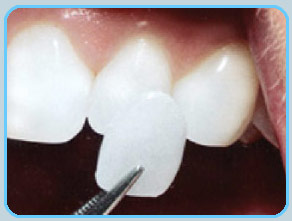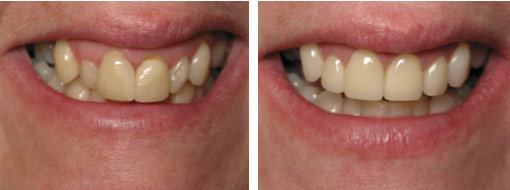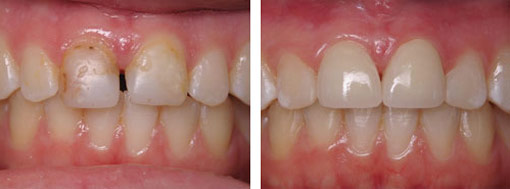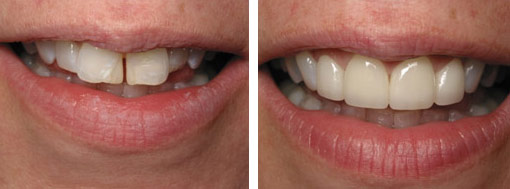
Dental Veneers at Torgersen Dental, Camarillo & Simi Valley
 Dental Veneers also known as "porcelain veneers or dental porcelain laminates" are thin shells of tooth-colored materials specially made to cover the front teeth to improve your appearance. These shells are attached to the front of the teeth, transforming their color, shape, size or length.
Dental Veneers also known as "porcelain veneers or dental porcelain laminates" are thin shells of tooth-colored materials specially made to cover the front teeth to improve your appearance. These shells are attached to the front of the teeth, transforming their color, shape, size or length.
Dental veneers can be made from porcelain or from resin combined materials. Porcelain veneers resist stains better than resin veneers and better mimic the light reflecting properties of natural teeth. Resin veneers are thinner and require less removal of tooth surface before placement. You will need to ask Drs. Trent or Gina Torgersen for advice on the best option for your dental needs .
Types of Problems That Dental Veneers Fix
Veneers are commonly used to repair:
- Discolored teeth– either because of root canal treatment;
stains from tetracycline or other drugs, excessive fluoride or other causes;
or the presence of large resin fillings that have discolored the tooth
- Worn teeth
- Chipped or broken teeth
- Misaligned, uneven, or irregularly shaped teeth (such as having craters or bulges in them)
- Gaps between teeth (to close the gap between these teeth)

Dental Veneers Before and After: Uneven Teeth

Dental Veneers Before and After: Chipped uneven teeth, discolored, and gaps

Dental Veneers Before and After: Gaps and Uneven Cracked Teeth
Procedure for Getting a Dental Veneer
Obtaining dental veneers usually requires three visits to Dr. Trent and Gina Torgersen – one for a consultation and two to assemble and apply the veneers. A tooth or teeth subjected to simultaneous processing of multiple veneers are described below.
Diagnosis and treatment planning.This first step requires active participation of you with Dr. Trent and Gina Torgersen. Describe to Dr. Trent and Gina Torgersen the result that you are trying to accomplish. During this appointment Dr. Trent and Gina Torgersen will examine your teeth to make sure that dental veneers are suitable for you and explain the entire procedure and some of its restrictions. They can also take X–rays and possibly make impressions of your mouth and teeth.
Preparation. To prepare a tooth for a veneer, Dr. Trent and Gina Torgersen will remove about half a millimeter of enamel from the tooth surface, which is almost the same thickness of the veneer to be added to the tooth surface. Before cutting of the enamel, you and Dr. Trent or Gina Torgersen will decide the need for a local anesthetic to numb the area. Next, Dr. Trent and Gina Torgersen will create a model or impression of your teeth. This model is sent to a local dental laboratory, which fabricates your veneer. It usually takes 2 weeks for Dr. Trent and Gina Torgersen to receive the veneers back from the laboratory. Temporary dental veneers can be placed to protect the teeth in the interim.
Bonding. Before the dental veneer is permanently bonded to your tooth, Dr. Trent and Gina Torgersen temporarily place the veneer on the tooth to examine its shape and color. They will may remove and adjust the veneer as needed to achieve the proper fit, the veneer color can be adjusted with the shade of cement used. Next, they prepare your tooth to receive the veneer, the tooth will be cleaned, polished and etched to allow a strong bond. Special cement is used for veneers, and the veneer is then placed on the tooth. Once it is at the correct position on the tooth, Dr. Trent and Gina Torgersen will apply a special light beam to the dental veneer, which activates chemicals in the cement causing it to harden very quickly. The last step is to remove any excess cement, evaluating your bite and to make final adjustments in the veneer as necessary. Dr. Trent and Gina Torgersen may ask you to return to visit 1–2 weeks to see how your gums react to the presence of your veneer and once again examine the veneer in general.
Advantages of Dental Veneers
Veneers offer the following advantages:
- They provide a natural appearance of your tooth.
- Gum tissue tolerates porcelain well.
- Porcelain veneers are stain resistant.
- The color of a porcelain veneer can be selected so that it makes dark teeth look whiter.
Veneers offer a conservative approach to change the color and shape of teeth –
veneers usually do not require extensive shaping prior to the procedure that crowns do,
but provide a more artistic substitute.
Disadvantages of Dental Veneers
The negative aspects of dental veneers include:
- The process is not reversible.
- Veneers are more expensive than composite resin bonding.
- Veneers are usually not repairable if they chip or crack.
- Because the enamel is removed, the tooth can become more sensitive to hot and cold foods and liquid refreshments.
- Veneers may not exactly match the color of your other teeth. In addition, the color of the veneer cannot be changed once in place. If you are planning to whiten your teeth, you should do so before acquiring veneers.
- Although unlikely, the veneers can loosen and fall off. To minimize the risk of this happening, avoid biting your nails, chewing on pencils, ice or other hard objects, or put too much pressure on your teeth.
- Teeth with veneers can still experience decay, possibly requiring a total coverage of the tooth with a crown.
- Veneers are not a good choice for people with unhealthy teeth (for example, those with extensive decay or gum disease on teeth), weakened teeth (due to decay, fracture or large dental fillings) or for those who have an insufficient amount of existing enamel on the surface of their tooth.
- Individuals who clench and grind their teeth are not suitable candidates for porcelain veneers, as these activities can cause the veneers to crack or chip.
Special Care for Dental Veneers
Dental veneers do not require any particular care. Continue to follow good oral hygiene practices, such as consistent brushing and flossing of your teeth. Even though porcelain veneers resist stains, Dr. Trent and Gina Torgersen may recommend that you avoid stain–causing foods and beverages like coffee, tea, or red wine.
Alternatives to Dental Veneers
Bondings and crowns are some of alternatives to veneers. Veneers offer a nice option in between. Veneers may be best suited for people who want to make something different on the shape of their teeth more than just a little –– as is done with bonding – but not enough to feel the necessity of a crown.
Call for your appointment today!


